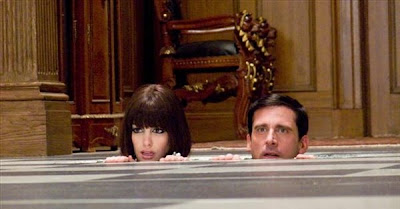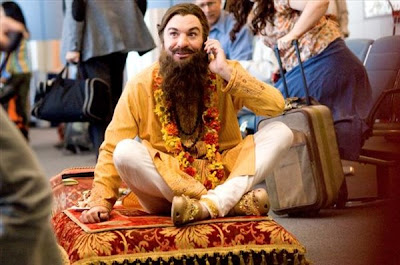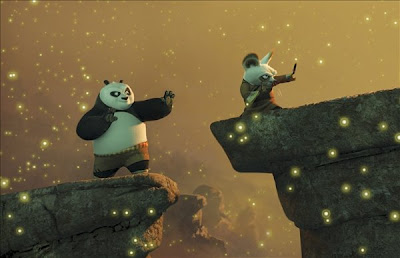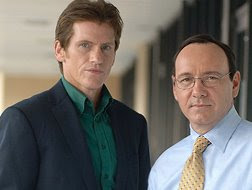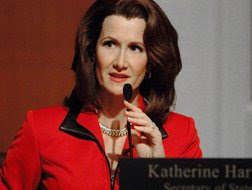
Featuring the voice talents of:
WALL∙E/M-O: Ben Burtt
EVE: Elissa Knight
Captain: Jeff Garlin
John: John Ratzenberger
Mary: Kathy Najimy
Ship’s Computer: Sigourney Weaver
Walt Disney Pictures and Pixar Animation Studios present a film written and directed by Andrew Stanton. Running time: 97 min. Rated G.
As a true film buff, I am fascinated with the magic of the motion picture experience. Even the most mundane movie has the potential to fill me with a sense of awe when experiencing it for the first time on a big screen with a booming soundtrack and those moving images washing over my field of vision. I often wonder what it must have been like to experience movies at their birth, when no one had ever seen a moving picture projected onto the screen before. And when sound was added, it must have been so shocking to see it synced up with the picture for the first time. There is something in the impact of those thoughts and possibilities that suggest the great potential of film as an art form. There is so much for it to live up to.
“WALL∙E”, the latest movie from the incredible minds at Pixar Animation Studios, is a film that comes close to realizing the perfection of the form. Perhaps the fact that the animated images of this film are computer generated is the natural progression of an art that is shaped from the artifice of capturing still images and placing them in a progression that suggests movement and reality. Does that make the fact that this is a movie about two robots who fall in love and show the human race how to become human again an irony or the inevitability of an art form that can do the same?
Pixar has a history of creating beautiful CG images in movies that are equally accomplished entertainments. In “Toy Story” we saw toys living in a world just as inventive as any kid’s imagination. “Finding Nemo” blended the ocean life we had seen in nature documentaries with a tale of love and hope as deep as the blue sea. The iconic feel of the road given to us mostly by movies was awarded a vibrant new perspective as a world populated by vehicles in “Cars”. But with “WALL∙E” it is like the shackles of convention have been cast aside—while not entirely thrown away—to give us a world, not so much based on another as it is explored for the first time by the characters within it.
The WALL∙E of the title is a janitor robot, seemingly the last of his kind. He was left on Earth as part of a worldwide cleanup project developed once the level of garbage from our throwaway society had gotten to the point where the planet could no longer sustain life. The project was conceived as a five year venture before humans could return. 700 years later, WALL∙E is still stacking cubes of compacted garbage into enormous towers.
One day a ship arrives and quite literally rocks WALL∙E’s world. The ship deposits another robot on the planet and leaves. This robot is EVE. EVE is looking for something. She—I say “she” because the filmmakers clearly suggest the male and female genders of the robots—is sleeker and more advanced than WALL∙E. For him, it’s a case of love at first sight despite the fact that her first instinct is to destroy him. Eventually, WALL∙E gains EVE’s trust and begins to introduce her to the pleasures of personality by showing her the vast collection of human memorabilia he has amassed during his years alone on the planet, including a video of “Hello Dolly” from which he has developed his own sense of romance and love.
The most amazing aspect of these introductory passages is the fact that all the story and emotions are conveyed without the use of dialogue. In this way, the movie is like a silent picture. The images become more important, and the audience is drawn further into the story than they might otherwise have been. And what beautiful images they are. The opening shot establishes so much of the plot’s details just by looking down on WALL∙E at his work amongst the garbage and the towers he has stacked. There is a sequence where the two robots exchange their names, but they seem to speak different languages at first, and so this limited conversation becomes a learning experience for both the characters and the audience.
When EVE finally finds what she was looking for, her ship is automatically notified and returns to retrieve her. WALL∙E stows away on the ship and discovers there is even more in the universe for him to explore. It is at this point that a genuine plot kicks in, and I suspect many critics will claim the portion of the film involving the humans is what might keep this visual masterpiece from being a total work of genius. But without the humans and their directive to return to Earth, two other important elements of what make for great filmmaking would be missing—the treasure of buried meaning and the thrill of entertainment.
The humans have spent their time devolving on a giant luxury space cruiser. Like the ultimate Carnival vacation, the humans spend their time doing nothing worthwhile. They are each carted around on their own personal floating deck chair. They never get or do anything on their own as their every need is attended to by robots. The entire ship is automated, and when EVE’s discovery and WALL∙E’s precocious personality disrupt the automated balance, the robot staff goes into lock down mode. One little robot named M-O is so focused on his job of scrubbing away any foreign substances that he develops his own psychologically imbalanced personality.
The presence of WALL∙E and EVE also peaks the Captain’s (voiced by Jeff Garlin, HBO’s “Curb Your Enthusiasm”) interest to the point where he becomes the first human in 700 years to ask questions about Earth and why the automation works the way it does. This sudden interest by a human in his own fate causes the autopilot to mutiny and our heroes are thrown into a thrilling action adventure. The sequence where EVE attempts to save WALL∙E from being ejected into space with the trash had me—dare I say—on the edge of my seat.
Throughout this entire plot the visual mastery of the picture remains its spotlight. The movie’s most beautiful sequence comes when WALL∙E and EVE dance through space around the giant star cruiser. WALL∙E is aided in flight by a fire extinguisher.
Even the closing credit sequence is a visual masterpiece. The backgrounds tell of a sort of new evolution for man where they return to Earth and learn again to care for themselves and the Earth, and evolve through a second industrialization of the world. The backgrounds start the story through hieroglyphics, then as each leap in civilization is made the art style changes from ancient forms through modern ones. The question is will history repeat itself, or do we get it right this time? We have so much to live up to. This movie does it.
WALL∙E/M-O: Ben Burtt
EVE: Elissa Knight
Captain: Jeff Garlin
John: John Ratzenberger
Mary: Kathy Najimy
Ship’s Computer: Sigourney Weaver
Walt Disney Pictures and Pixar Animation Studios present a film written and directed by Andrew Stanton. Running time: 97 min. Rated G.
As a true film buff, I am fascinated with the magic of the motion picture experience. Even the most mundane movie has the potential to fill me with a sense of awe when experiencing it for the first time on a big screen with a booming soundtrack and those moving images washing over my field of vision. I often wonder what it must have been like to experience movies at their birth, when no one had ever seen a moving picture projected onto the screen before. And when sound was added, it must have been so shocking to see it synced up with the picture for the first time. There is something in the impact of those thoughts and possibilities that suggest the great potential of film as an art form. There is so much for it to live up to.
“WALL∙E”, the latest movie from the incredible minds at Pixar Animation Studios, is a film that comes close to realizing the perfection of the form. Perhaps the fact that the animated images of this film are computer generated is the natural progression of an art that is shaped from the artifice of capturing still images and placing them in a progression that suggests movement and reality. Does that make the fact that this is a movie about two robots who fall in love and show the human race how to become human again an irony or the inevitability of an art form that can do the same?
Pixar has a history of creating beautiful CG images in movies that are equally accomplished entertainments. In “Toy Story” we saw toys living in a world just as inventive as any kid’s imagination. “Finding Nemo” blended the ocean life we had seen in nature documentaries with a tale of love and hope as deep as the blue sea. The iconic feel of the road given to us mostly by movies was awarded a vibrant new perspective as a world populated by vehicles in “Cars”. But with “WALL∙E” it is like the shackles of convention have been cast aside—while not entirely thrown away—to give us a world, not so much based on another as it is explored for the first time by the characters within it.
The WALL∙E of the title is a janitor robot, seemingly the last of his kind. He was left on Earth as part of a worldwide cleanup project developed once the level of garbage from our throwaway society had gotten to the point where the planet could no longer sustain life. The project was conceived as a five year venture before humans could return. 700 years later, WALL∙E is still stacking cubes of compacted garbage into enormous towers.
One day a ship arrives and quite literally rocks WALL∙E’s world. The ship deposits another robot on the planet and leaves. This robot is EVE. EVE is looking for something. She—I say “she” because the filmmakers clearly suggest the male and female genders of the robots—is sleeker and more advanced than WALL∙E. For him, it’s a case of love at first sight despite the fact that her first instinct is to destroy him. Eventually, WALL∙E gains EVE’s trust and begins to introduce her to the pleasures of personality by showing her the vast collection of human memorabilia he has amassed during his years alone on the planet, including a video of “Hello Dolly” from which he has developed his own sense of romance and love.
The most amazing aspect of these introductory passages is the fact that all the story and emotions are conveyed without the use of dialogue. In this way, the movie is like a silent picture. The images become more important, and the audience is drawn further into the story than they might otherwise have been. And what beautiful images they are. The opening shot establishes so much of the plot’s details just by looking down on WALL∙E at his work amongst the garbage and the towers he has stacked. There is a sequence where the two robots exchange their names, but they seem to speak different languages at first, and so this limited conversation becomes a learning experience for both the characters and the audience.
When EVE finally finds what she was looking for, her ship is automatically notified and returns to retrieve her. WALL∙E stows away on the ship and discovers there is even more in the universe for him to explore. It is at this point that a genuine plot kicks in, and I suspect many critics will claim the portion of the film involving the humans is what might keep this visual masterpiece from being a total work of genius. But without the humans and their directive to return to Earth, two other important elements of what make for great filmmaking would be missing—the treasure of buried meaning and the thrill of entertainment.
The humans have spent their time devolving on a giant luxury space cruiser. Like the ultimate Carnival vacation, the humans spend their time doing nothing worthwhile. They are each carted around on their own personal floating deck chair. They never get or do anything on their own as their every need is attended to by robots. The entire ship is automated, and when EVE’s discovery and WALL∙E’s precocious personality disrupt the automated balance, the robot staff goes into lock down mode. One little robot named M-O is so focused on his job of scrubbing away any foreign substances that he develops his own psychologically imbalanced personality.
The presence of WALL∙E and EVE also peaks the Captain’s (voiced by Jeff Garlin, HBO’s “Curb Your Enthusiasm”) interest to the point where he becomes the first human in 700 years to ask questions about Earth and why the automation works the way it does. This sudden interest by a human in his own fate causes the autopilot to mutiny and our heroes are thrown into a thrilling action adventure. The sequence where EVE attempts to save WALL∙E from being ejected into space with the trash had me—dare I say—on the edge of my seat.
Throughout this entire plot the visual mastery of the picture remains its spotlight. The movie’s most beautiful sequence comes when WALL∙E and EVE dance through space around the giant star cruiser. WALL∙E is aided in flight by a fire extinguisher.
Even the closing credit sequence is a visual masterpiece. The backgrounds tell of a sort of new evolution for man where they return to Earth and learn again to care for themselves and the Earth, and evolve through a second industrialization of the world. The backgrounds start the story through hieroglyphics, then as each leap in civilization is made the art style changes from ancient forms through modern ones. The question is will history repeat itself, or do we get it right this time? We have so much to live up to. This movie does it.
